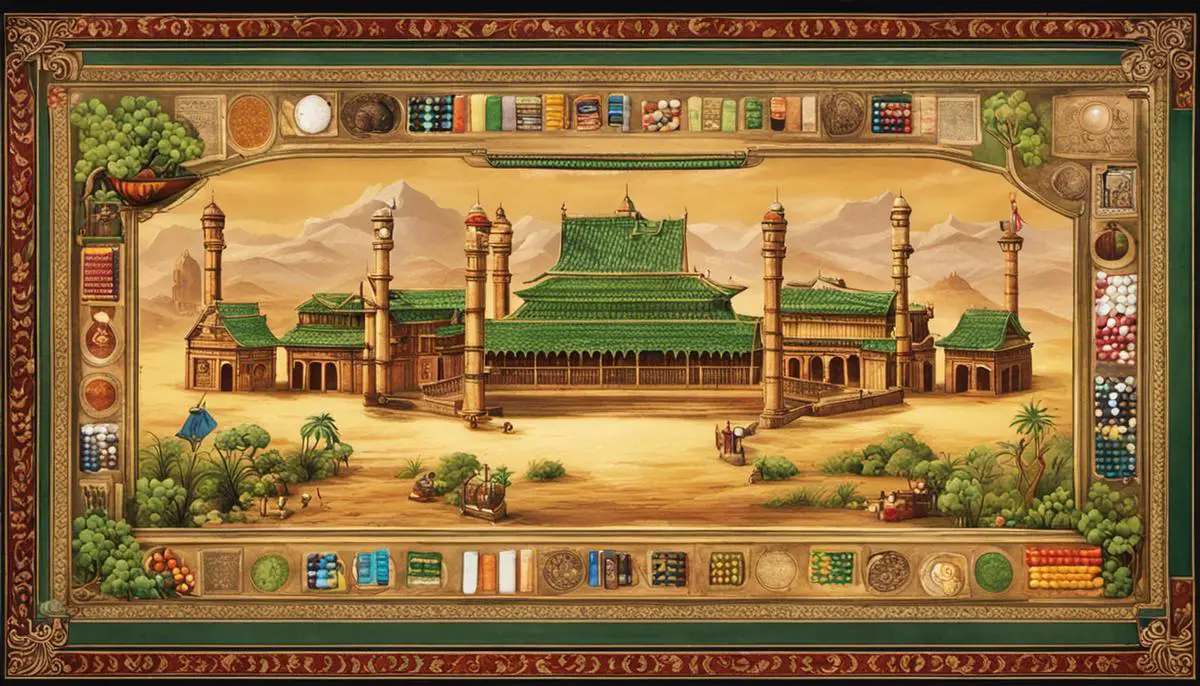Prepare to embark on an ancient Aztec journey where strategy, forethought, and skill intertwine in the captivating game of Patolli. With historical roots as deep as civilization itself, this time-tested board game captivates with its blend of simple rules and complex tactics. To master Patolli, requires not only an understanding of the game’s rules and setup but, more crucially, an effective strategy, constant practice, and in-depth analysis of successful plays. It’s not merely about moving pieces and scoring points; Patolli is about ensuring each move gives you an advantage while limiting your opponent’s options, hence creating a sublime demonstration of cognitive agility.
Understanding the rules of Patolli
Understanding Patolli: The Ancient Aztec Game
Patolli is a strategic board game that was highly popular among the ancient Aztec civilization. It’s a game that requires two players, each of whom have their own set of six tokens. They must try to move their tokens around the cross-shaped game board with the goal of removing all the opponent’s tokens before their own.
Setting Up The Game
The game board for Patolli is traditionally cross-shaped, broken up into several squares. There are 52 squares in total, divided into four arms with 13 squares each. Each player has a set of six markers, which they place on the board to start the game. Five beans, often painted on one side, serve as a form of dice.
Player Movements
Players take turns tossing the beans. The number of beans that lands with the painted side upward determines how many squares a player can move one of their markers. A roll of five, however, corresponds to a ten-space move. If a marker lands on an opponent’s space, the opponent’s marker is removed from the game. If a marker completes a circuit around the board, they are safe and removed from the game.
Scoring in Patolli
The winner of the game is the first player to successfully get all of their markers off the board. This requires not just luck with the bean tosses, but also careful strategy to block or knock out the other player’s markers.
Developing Winning Strategies
Winning at Patolli requires a balance of offensive and defensive strategies. Blocking the path of your opponent can stop them from moving their markers forward. It’s a good idea to spread out your own markers to increase the chances of landing on your opponent’s markers. Since the chances of rolling a one or two are higher than rolling a four or five, positioning your markers around four to five spaces behind your opponent can increase the likelihood of knocking out their markers.
Patolli is not just a game of chance but also of strategy. Playing it requires a good understanding of both the rules and the strategies to maximize your chances of winning.

Developing an effective strategy
Understanding the Basic Game Rules
Patolli is a two-player game, where each player has six markers that they must move around a standardized cross-shaped track. The game begins with each player rolling five beans, which act as the game’s version of dice. The number of beans with visible white marks determines the number of spaces a player moves in a turn.
Managing Your Beans Effectively
Winning at Patolli largely hinges on effective use of beans(referring to the dice in this game). Each roll of the beans can result in a variety of moves, which range from 1-5 steps. Having a clear understanding of the odds tied to each roll helps tremendously. For instance, the odds of landing a 1, 2 or 3 are higher than landing a 4 or 5. By better understanding the odds, you can plan ahead and anticipate possible moves.
Prioritizing Piece-Safe Strategies
Marcadores (the markers) hold a key role in deciding who wins or loses the game. Since there are only four safe spots (the corners of the board), positioning your marcadores to occupy these spaces is a crucial part of your strategy. These markers will move to the center square, and finally out of the board. It is advantageous to space your pieces in a way that enables you to block opponents or provide options for subsequent turns, increasing the likelihood of reaching the center square and successfully exiting.
Blocking Opponent Strategies
Use your beans’ roll to strategize and potentially block your opponent. If your opponent’s marker is two spaces ahead of you and you roll a two, move to that space. This will require your opponent to reroll their turn, giving you a stronger chance to advance your markers or potentially cause them to lose markers due to rules on landing on a square occupied by the opponent.
Planning Your Moves Ahead
Winning Patolli requires forward-thinking strategies and foresight. Study the board before making a move. Predict where your opponent may land next and try to strategize your moves in a way that will create the most obstacles for them. It’s also worth noting that eliminating all of your opponent’s pieces doesn’t equal an automatic win. The primary goal is to get all your markers off the board first.
Choosing the Right Bets
Patolli is also uniquely a gambling game. Each player brings six items to wager, and the first player to lose all six markers loses the game. Good strategic bets can help restrain your opponent’s moves, as players have to avoid spaces that their opponents have placed bets on. Be mindful of what you wager, as high-stakes bets could make your opponent even more strategic.

Practicing the game
Understanding the fundamentals of Patolli
Before you can start practicing the game of Patolli, it’s essential that you understand its fundamentals. Patolli is an ancient Aztec board game that involves strategy and probability. The game is played on a cross-shaped board with spaces along the lines of the cross. Each player has six markers, and the goal is to move all of them from the start to the end before your opponent does.
Practice with the Game Components
Understanding the game components is the first step in practicing Patolli. The game components include a cross-shaped board, six tokens for each player, and five beans, which are used like dice. The beans are marked on one side and are left unmarked on the other. By flipping these beans, you determine the number of spaces you can move your tokens on the board, with the number of marked sides indicating the number of moves.
Learn and Apply the Game Rules
Once you’re familiar with the game components, start learning and applying the Patolli rules. Start your game by placing your tokens on designated locations on your side of the board. On your turn, you cast the beans. Based on the number of beans that land marked-side-up, move your tokens forward [0 (if all blank) to 5 (if all marked)] spaces, clockwise. If you land on an opponent’s marker, you swap places with them. If two of your markers land on the same space, it forms a blockade that an opponent must overcome before proceeding. The first player to move all their markers off the board is the declared winner.
Applying Strategic Play
While luck plays a part in Patolli due to the reliance on the throw of beans, there is a significant element of strategy as well. Practice using strategic decisions like deciding which marker to move during your turn, anticipating your opponent’s moves, and strategically forming blockades to prevent your opponent from advancing. Consider your movements carefully and think several steps ahead.
Engaging in Regular Practice Games
To truly refine your skills and become proficient at Patolli, make it a point to regularly engage in practice matches. Playing with different opponents will expose you to various strategies and gameplay styles. The more games you play, the better your understanding of the game’s intricacies and the more effective your strategies will become.
Analyzing Your Performance
As part of your practice, it’s important to take the time to analyze your own performance. Take note of where you made mistakes or missed opportunities during the game. Identifying these errors can help you improve your strategies and decision-making skills for future games. A great player not only plays but also learns from each game they play.
Experimenting with Different Strategies
Don’t be afraid to experiment with different strategies while you’re practicing Patolli. Try out different tactics and analyze their effectiveness in different situations. This way, you’ll develop a broad array of strategies to draw upon during gameplay, improving your chances of winning regardless of the situation.
By applying these instructions, you’ll enrich your understanding of Patolli, improve your strategies, and increase your chances of winning. Just remember, similar to any other game, practice is key. Keep playing, keep learning, and keep enjoying the game.

Analyzing successful plays
Delving into Past Victories: A Key to Better Strategies
The starting point to gaining success in Patolli, the ancient Aztec game believed to have spiritual or ritualistic significance, is to study your past victorious games. Sleuthing your own performance can offer you valuable insights into what you did right, where you excelled, and what tactics effectively worked for you.
Don’t just focus on the big picture – the fact that you won – but instead scrutinize every turn you took, every decision you made. Did you play aggressively or defensively? What was your response when you faced a roadblock or had to make a decision under pressure? Identifying what worked well in your favor the last time you won will give you leverage in future games.
Spot Your Shortcomings: Room for Improvement
Now that you have noted the highlights of your past victories, turn your attention toward the areas where you could improve. Remember, not every triumph is perfect and there’s always something to be learned.
Ask yourself if there were less efficient moves you made during the game, or moments when you took unnecessary risks. Look at areas in which you could have played better. Was there a point in the game where you could have taken a different decision that might have ensured a quicker or smoother victory? Based on your answers, refine your strategies.
Empathizing with Your Opponent: Decoding Opposition Strategy
Understanding your opponent’s strategies is equally as important as knowing your own. When you won the game, what were the strategies and moves used by your opponent? By answering these questions, you can gain insights into your opponent’s thought process and strategies, which will help you predict their moves and outplay them in future games.
Flexible Game Plan: Adapting to New Strategies
Every player is different and comes with their own unique set of strategies. As you accumulate game experiences, your understanding of the game will deepen and your strategies should evolve. Smart adaptation is key in Patolli. Be prepared to modify your game plan in order to suit the unique situation you find yourself in each game.
By meticulously scrutinizing your past victories, improving your own game strategy, understanding your opponents, and keeping your strategies flexible, your mastery over Patolli will only improve. Patience, observation, and practice are your allies, so use them wisely.

After diligent practice and meticulous analysis of your games, you’ll begin to notice improvements in your performance and strategy. The beauty of Patolli, like any other board game, lies not in mere victory, but in the intellectual challenge and the strategic maneuvers it demands. Adept players learn to utilize every chance they get, counter every threat, and capitalize on their opponent’s mistakes. As you continue to evolve as a Patolli player, remember that every victory and every loss is a lesson to be learned; a step closer to mastering this enthralling game. With time, patience, and practice, you’ll go from novice to expert, mastering the game just as the ancient Aztecs did centuries ago.
